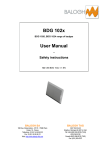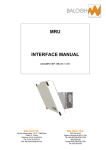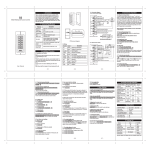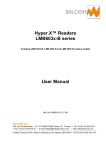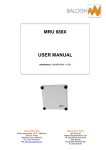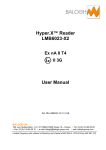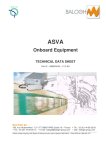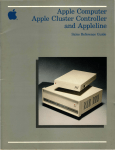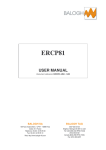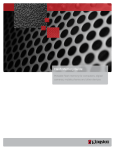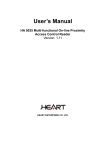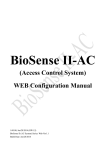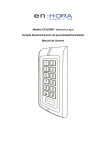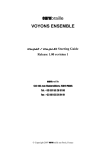Download LPR3033-3034 & 3035 USER MANUAL
Transcript
LPR3033-3034 & 3035 USER MANUAL REFERENCE DOCUMENT: LPR303x-UM-1.4-EN BALOGH SA BALOGH TAG 189 Rue d’Aubervilliers - CP 97 - 75886 Paris Cedex 18 - France Téléphone: 33 (0)1 44 65 65 00 Fax: 33 (0)1 44 65 65 10 Web: http://www.balogh-rfid.com 3637 Old US-23 Brighton, Michigan MI 48114, USA Tel: USA (800) 252-RFID (7343) (810) 360-0182 Canada (800) 258-RFID (7343) Fax: (810) 360-0237 LPR303x Blank page 2/26 LPR303x-UM-1.4-EN LPR303x TABLE OF CONTENTS FOREWORD ................................................................................... 4 1 1.1 1.2 1.3 1.4 2 PURPOSE OF THIS MANUAL ....................................................................... 4 DOCUMENT NAMING CONVENTIONS......................................................... 4 DOCUMENT STATUS SHEET ....................................................................... 4 NOTE .............................................................................................................. 4 DESCRIPTION OF READER .......................................................... 5 2.1 2.2 2.3 2.4 2.5 2.6 3 GENERAL DESCRIPTION ............................................................................. 5 WARNINGS .................................................................................................... 5 OPERATING PRINCIPLE ............................................................................... 5 COMMUNICATION INTERFACES ................................................................. 6 MODELS AVAILABLE .................................................................................... 6 OVERALL DIMENSIONS ................................................................................ 6 INSTALLING THE LPR303x READER ........................................... 7 3.1 3.2 3.3 4 MOUNTING ON A POLE ................................................................................ 7 MOUNTING ON A WALL ................................................................................ 9 POSITIONING OF READER ........................................................................ 11 CONNECTORS AND INTERFACES ............................................. 13 4.1 4.2 4.3 4.4 4.5 5 CONNECTOR N°1: POWER AND OPEN COLLECTOR INTERFACE......... 14 CONNECTOR N°2: INPUT/OUTPUT ........................................................... 16 CONNECTOR N°3: ASYNCHRONOUS SERIAL LINK................................. 18 CONNECTOR N°4: USB .............................................................................. 21 CONNECTOR N°5: ETHERNET................................................................... 22 IN SERVICE OPERATION ............................................................ 23 5.1 5.2 5.3 5.4 6 POWER SUPPLY ......................................................................................... 23 OPERATION OF THE INDICATOR LIGHT .................................................. 23 READER PARAMETERS (DEFAULT VALUES)........................................... 23 CHANNEL FREQUENCIES .......................................................................... 24 MAINTENANCE ............................................................................ 25 6.1 6.2 6.3 7 PERIODIC MAINTENANCE ......................................................................... 25 REPLACEMENT ........................................................................................... 25 RECYCLING ................................................................................................. 25 LEGAL INFORMATION................................................................. 26 7.1 7.2 7.3 CE NOTICE .................................................................................................. 26 LABEL ON REAR PANEL ............................................................................. 26 TECHNICAL CHARACTERISTICS AND DIMENSIONS............................... 26 3/26 LPR303x-UM-1.4-EN LPR303x 1 FOREWORD 1.1 PURPOSE OF THIS MANUAL This manual presents the BALOGH HYPER X readers LPR3033- LPR 3034 and LPR 3035. In this manual these readers are named LPR303x It describes how to install and how to use it. Further information pertaining to the data interfaces described in this manual can be found in the Interface Manual (reference LPR303x-IM-x.y-EN). 1.2 DOCUMENT NAMING CONVENTIONS The coding used for a manual name is: <device name>- UM-II-L in which: UM signifies User Manual II refers to the issue or version number L refers to the language of the manual 1.3 DOCUMENT STATUS SHEET Version 1.0 1.1 and 1.2 Date 02/06/2012 1.3 14/06/2012 1.4 30/8/2013 Description of changes Creation (translation of French version 1.2) unused Minor and topographic corrections Synchronization with French version 1.3 Introduction of LPR 3033 - 3035 1.4 NOTE The contents of this manual are subject to changes without notice. BALOGH cannot be held responsible for the consequences of any error, omission, or incorrect interpretation of the information provided. 4/26 LPR303x-UM-1.4-EN LPR303x 2 DESCRIPTION OF READER 2.1 GENERAL DESCRIPTION LPR303x readers will identify HyperX™ tags on the fly at distances of up to 4m for LPR3033, up to 6m for LPR3034 and up to 10m for LPR3035. Reader distance up to LPR3033 4m LPR3034 6m LPR3035 10m The reader is a compact all-in-one device. The weatherproof housing of sober design contains all the functional elements of the reading unit: Antennas, Microwave generator, receiver, CPU and communication interface. The reader can be mounted directly onto any panel, even a metallic one. An optional tilt and swivel mount allows installation on both poles and flat surfaces. In this way the antenna can be appropriately pointed to the zone where the tags need to be identified. The main characteristics are as follows: • • • • • • • Case dimensions: 276x186x30mm Overall dimensions: 276x186x57mm Weight: 2.5 kg Cover color: Grey RAL 7035 IP65 protection Power requirements: between +12Vdc and +24Vdc, max current 1.5A. Operating temperature: -20°C to +50°C 2.2 WARNINGS Tags may be damaged or deprogrammed if used in the immediate vicinity of GSM mobile phones. A safety distance of at least 10 cm must be maintained between the tags and the mobile phones. Installation of long-range readers must only be done in zones where the technical and environmental conditions comply with those specified by the manufacturer. BALOGH cannot be held responsible for any damages caused by an incorrect installation. Any changes made to the device will immediately nullify the warranty. 2.3 OPERATING PRINCIPLE Electromagnetic radiation in the frequency range 1 to 100 GHz is called microwaves. Their physical characteristics allow high data rates and good directivity. Reading antennas are smaller and performance is relatively independent of the environment. Tags are not active when not in the reader's antenna zone. The tag's originality (patented) is its capacity to reflect the microwaves emitted by the readers. A tag receiving an incident unmodulated 2.45 GHz carrier, will reflect this wave but modulated by its own identification code. The reader receives and processes this signal and then converts and sends the data to a host system over a standardized connection. 5/26 LPR303x-UM-1.4-EN LPR303x 2.4 COMMUNICATION INTERFACES These readers can be used in place of most conventional controllers, both contact and contact-less. Communication with a "host" system takes place using the following standardized links: : • Open-collector: DATA/CLOCK, WIEGAND 26bits • Serial asynchronous: RS232, RS422 or RS485 ETHERNET USB (also used for maintenance). For the USB, RS and ETHERNET links, full two-way communication is possible using the MODBUS™ protocol. For some versions, all the interfaces are not available simultaneously. These readers are also equipped with: • An opto-coupled digital output that can be configured to switch either via a command sent from the host or automatically at each tag identification. • An opto-coupled digital input which can be used to globally enable or disable tag reading. The readers must be powered with 12 - 24 VDC. A special detector ensures that if the input voltage is too low then the reader will not power up. Powering the reader from a mains outlet requires an AC adaptor of at least 18W. 2.5 MODELS AVAILABLE • LPR303x TTL Wiegand 26 bits and DATA/CLOCK USB for maintenance • LPR303x ETH Wiegand 26 bits and DATA/CLOCK RS 232, RS 422, RS 485 ETHERNET USB (also used for maintenance). 2.6 OVERALL DIMENSIONS 6/26 LPR303x-UM-1.4-EN LPR303x 3 INSTALLING THE LPR303x READER At the rear of the reader are two mounting brackets. These brackets have self-clinching nuts size M6 allowing mounting on any support structure (e.g. support angles with screws) These brackets also have oblong holes allowing plastic or metallic collars to pass through. A mounting kit allowing easy installation of the reader is available as an accessory. This kit contains: - a tilt bracket which allows adjusting the tilt angle - a wall-mounting support which allows adjustment of horizontal rotation - 2 metallic hose clamps Ø30mm for attaching the tilt mount onto the support structure - 4 mounting screws for attaching the reader onto the tilt bracket All the pieces are made of stainless steel. 3.1 MOUNTING ON A POLE 3.1.1 DIRECT MOUNTING The reader can be mounted directly onto a pole by with a hose clamp that passes through the openings in the brackets. This type of mount only allows horizontal rotation: LPR303x pole side view hose clamp LPR303x pole hose clamp top view 7/26 LPR303x-UM-1.4-EN LPR303x 3.1.2 MOUNTING USING THE TILT BRACKET The reader is mounted onto the bracket using the 4 screws provided, the bracket is mounted onto the pole using the hose clamps. Depending on the diameter of the pole, the hose clamps provided may be suitable, otherwise larger hose clamps (not provided) may be needed. This type of mount allows both horizontal and vertical rotation. LPR303x tilt bracket pole hose clamp side view LPR303x tilt bracket pole hose clamp top view The tilt angle can range from 5° upwards to 45° downwards 8/26 LPR303x-UM-1.4-EN LPR303x 3.2 MOUNTING ON A WALL 3.2.1 MOUNTING USING THE TILT BRACKET The tilt bracket has 4 holes for wall mounting. - 4 screws Ø6mm max screw type must be chosen to suit wall material 40mm between axes in both directions LPR303x tilt bracket side view wall LPR303x tilt bracket wall top view This type of mount only allows a vertical tilt adjustment from 5° upwards to 45° downwards. Note: by rotating the bracket 90° (wings are horizontal), horizontal rotation becomes possible. 9/26 LPR303x-UM-1.4-EN LPR303x 3.2.2 MOUNTING WITH WALL BRACKET This bracket, provided in the kit, has 4 mounting holes, whose locations are identical to those of the tilt bracket. Mounting onto the wall is identical: The tilt bracket is attached to the wall bracket with the 2 metallic hose clamps provided. This type of mount allows both horizontal and vertical rotation: LPR303x tilt bracket hose clamp side view wall bracket wall LPR303x tilt bracket wall bracket wall top view The tilt angle can range from 5° upwards to 45° downwards. With the reader pointing 45° downwards and mounted on a wall, the maximum horizontal rotation is roughly 30°. When there is no tilt, the horizontal rotation can reach 50° on either side. 10/26 LPR303x-UM-1.4-EN LPR303x 3.3 POSITIONING OF READER The directivity of the reader's antenna is a symmetrical 45° x 45°. Mounting the reader horizontally or vertically does not affect its performance. Side view Top view y z 45° 45° y z Position the reader so that it points to the zone where the tags are likely to be. Maximum performance is always achieved with the line of sight perpendicular to the face of the reader. With the mounting elements provided, the reader can now be pivoted. The orientation can be freely adjusted. Pivoting can be either horizontal (side to side) or vertical (up and down). When positioning the reader, the following recommendations should be followed: Avoid placing the reader in direct sunlight, where overheating may cause the internal electronics to reach temperatures above those recommended for normal operation. If this is not possible then a sun-shield should be mounted. When two or more readers are situated in the same zone, make sure they are not pointing towards each other. If necessary, their pointing axes should be slightly redirected. The frequency channels should be as far apart as possible. A separation of 0.750 MHz is recommended for readers situated close together (see the frequency table at the end of the manual). Do not install a reader close to a source of potential interference in order not to degrade its performance. The indicated reading distance is a nominal value and the actual range is usually greater. However there are several sources of interference present in the environment which may affect reader performance and which must be taken into account. Quite often this interference cannot be removed and results in a reduced reading range. The main sources of interference are: Devices operating in the same band of frequencies, such as wireless communications (WLAN), Mobile phones and smartphones, Microwave ovens, Fluorescent lighting, Metal objects such as gratings, fences or heat-reflective vehicle windscreens, Etc. 11/26 LPR303x-UM-1.4-EN LPR303x Typical installation: Inclined frontal reading zone 1 Theoretical identification zone 2 Reader. The reader should be positioned so that the angle is between about 30 and 45 degrees down towards the vehicle. 1 The tag, fastened on the windscreen, should be inclined between 30 to 45 degrees for an optimal alignment with the reader. 2 Theoretical identification zone 3 Reader. The reader should be positioned so that the angle is between about 30 and 45 degrees. The diagram above shows the best reader/tag orientation. In particular it avoids unwanted identifications in front of but far from the reader. For best results, the tag surface and the reader surface should be parallel. In this case, the tag reflects the maximum of the received signal. When a tag is fixed to the vehicle windscreen, be aware of the presence of metalized areas (for heat reflection) which can degrade or prevent tag identification. Contact BALOGH for recommendations on best practices for tag positioning. 12/26 LPR303x-UM-1.4-EN LPR303x 4 CONNECTORS AND INTERFACES All the reader's connectors are found on the rear panel. All connectors are panel mounts using the M12 standard. Moulded cable assemblies of different lengths are available from several manufacturers. Manual assembly of cable connectors allows choosing between soldered, crimped or screw-terminal connections. ATTENTION: these M12 type connectors are designed for hand-tightening only. Spanners or pliers must not be used in order not to cause damage. Connector numbers (rear view of LPR-303x) 1 2 3 4 5 The model LPR303x ETH, is equipped with three serial data interfaces: USB, ETHERNET, RS. These three cannot operate simultaneously, only one at a time can be used. Selection is done automatically when cables are connected, according to the following priority: USB > ETHERNET > RS The USB interface has priority over the Ethernet interface, so the USB cable must be removed in order to use the Ethernet interface. Similarly, the Ethernet interface has priority over the RS interface, so the Ethernet cable must be removed in order to use the RS interface. 13/26 LPR303x-UM-1.4-EN LPR303x 4.1 CONNECTOR N°1: POWER AND OPEN COLLECTOR INTERFACE M12 plug, A-coding, male, 5 pins. Connector pinout, front view: POWER 1 2 3 4 5 Open Collector DATA/CLOCK WIEGAND +DC DATA DATA “0” CLOCK DATA “1” GND GND 0V The cable connector must be type M12 A-coding, female, 5 pins. This connector has 2 functions: reader power supply and open collector interface for DATA/CLOCK and WIEGAND 4.1.1 READER POWER SUPPLY The reader requires a DC power supply of between 12Vdc and 24Vdc applied between pins 1 and 4 of the connector. Current drawn is 1.5 A maximum during power-up surge. Average currents for steady-state operation are given in the following table: Input Voltage TTL Model RS-ETH Model 12V 550mA 600mA 24V 350mA 400mA The reader electronics are protected against polarity inversion for the power supply connection. Pay careful attention to the length and gauge of the wire used. As ohmic losses in the power lead can cause a voltage drop, make sure the input voltage to the reader is greater than 11.5V. If the power supply cannot provide sufficient current during the power-up, the front-panel light will blink red. This is not a fault condition, but an indication that a better-dimensioned power supply must be used.. 4.1.2 OPEN-COLLECTOR LINK: Different signals appear on the pins depending on which interface is selected. pin 1 2 3 4 5 DATA/CLOCK WIEGAND DATA CLOCK DATA “0” DATA “1” GND GND 14/26 LPR303x-UM-1.4-EN LPR303x - Circuit diagram for open collector output: - reader connections for DATA-CLOCK: - reader connections for WIEGAND 15/26 LPR303x-UM-1.4-EN LPR303x 4.2 CONNECTOR N°2: INPUT/OUTPUT M12 plug, A-coding, female, 5 pins. Connector pinout, front view: 1 E+ 2 E– INPUT 3 SV 4 S+ OUTPUT 5 S– The cable connector must be type M12 A-coding, male, 5 pins. A 4-pin connector can be used if the output is not used. 4.2.1 INPUT Circuit diagram for digital input: The digital input uses an optocoupler to provide galvanic isolation from the reader electronics. An open circuit or a positive voltage less than 4.4V applied to the pin E+ will produce the internal logic state "1", a voltage between 7.1V and 24V will produce the state "0". This input is sampled and the state updated every 50ms. If the applied voltage is greater than 7.1V, the bit E1 of the status word is reset to 0. During normal operation, the applied voltage should not be above 24V. This input allows enabling or disabling tag reading, e.g. when a loop vehicle detector provides a control signal. 16/26 LPR303x-UM-1.4-EN LPR303x 4.2.2 OUTPUT Circuit diagram for digital output:: The digital output uses an optocoupler to provide galvanic isolation from the reader electronics. Enabling the output turns the output transistor and current is drawn from an external voltage applied on the SV pin. The load is connected between pins S+ and SV. The collector current will induce a voltage of about 1V between these two pins. If the output is disabled, the transistor is turned off and the voltage on pin S+ will be equal to that on pin SV. This output is designed to control a 12V or 24V relay. The current available is typically 100mA. 4.2.3 TYPICAL WIRING DIAGRAM FOR CONNECTING A BUZZER OR RELAY: 17/26 LPR303x-UM-1.4-EN LPR303x 4.3 CONNECTOR N°3: ASYNCHRONOUS SERIAL LINK This connector is only present in the LPR303x ETH model The model LPR303x ETH is equipped with three serial data interfaces: USB, ETHERNET, RS. These three cannot operate simultaneously, only one at a time can be used. Selection is done automatically when cables are connected, according to the following priority: USB > ETHERNET > RS In order to use the RS interface it is necessary to disconnect any cables on the Ethernet and USB connectors. M12 plug, A-coding, female, 5 pins. Connector pinout, front view: pin 1 2 3 4 5 RS-232 TX — — RX GND RS-422 TX+ TX– RX+ RX– GND RS-485 V1+ V1– V2+ V2– GND The cable connector must be type M12 A-coding, male, 5 pins. Different signals appear on the pins depending on which interface is selected. 4.3.1 WIRING DIAGRAMS FOR HOST CONNECTIONS Reader connections for RS-232: 18/26 LPR303x-UM-1.4-EN LPR303x Reader connections for RS-422 (full-duplex): Reader connections for RS-485 (full-duplex): Network connections (bus, simplex). R R must be connected if necessary Network connections (bus, half-duplex). R R R must be connected if necessary 19/26 LPR303x-UM-1.4-EN LPR303x 4.3.2 ELECTRICAL CONNECTIONS Cables to use for RS-422 and RS-485 links • In the absence of electrical noise - unshielded twisted pairs. • In a noisy environment - individually shielded twisted pairs Cables are characterized by: - their characteristic impedance (Z0 in ohms) - their distributed capacity (CL in pF/m). - their distributed resistance (RL in ohms/m) For short cable lengths, normal cables are satisfactory. For cables longer than 1000 m, high quality cables (low CL and RL) should be used for all baud rates. Signal inversions For an RS-232 link, signal polarities and levels are well defined. On both devices RX is connected to TX and vice-versa. For an RS-422 or RS-485 link, the signal “+” is normally at a high level at rest and active low, the reverse is true for the signal "–". This is the case for this reader. If however the differential signals are generated by a converter from an RS-232 interface, then the “+” line can be at a low level at rest and active high. In this case, the signals must be inverted. Half-duplex interface In the case of an RS-485 “2-wire” (half-duplex) link, the signals V1+ and V2+ must be connected together and connected to the V+ pin on the host device. Similarly, the signals V1– and V2– must be connected together and connected to the V– pin on the host device. Connection of GND For an RS-232 link, the GND of each equipment must be at the same potential. Consequently, the signal GND (pin 5 on connector) must be connected to the chassis of the host equipment. For a differential link, this GND connection is not absolutely necessary but often recommended. Line termination For baud rates not greater than 1200bps, no termination is necessary. For baud rates greater than 9600bps and line lengths greater than a few hundred meters, a resistor equal to the line impedance (≈120 ohms) is essential. For a simplex link (one-way), the termination (if present) should be placed at the receiving end.. For a duplex link (two-way), the termination (if present) should be placed at each end of the line. Line biasing For RS-422 and RS-485 links, biasing may be necessary. This is done externally and only at one point on the line. The line “+” is connected to +5V via a 4.7K resistor. The line “–” is connected to GND via a 4.7K resistor. 20/26 LPR303x-UM-1.4-EN LPR303x 4.4 CONNECTOR N°4: USB The model LPR303x ETH is equipped with three serial data interfaces: USB, ETHERNET, RS. These three cannot operate simultaneously, only one at a time can be used. Selection is done automatically when cables are connected, according to the following priority: USB > ETHERNET > RS In order to use the RS interface it is necessary to disconnect any cables on the ethernet and USB connectors. The USB interface has priority over the other interfaces, so the USB cable must be removed in order to use the ethernet or RS interfaces. M12 plug, A-coding, female, 8 pins. Connector pinout, front view: 1 2 3 4 5 6 7 8 VUSB (+5V) DATADATA+ CHASSIS do not connect do not connect do not connect do not connect USB RESERVED (TEST) The cable connector must be type M12 A-coding, male, 8 pins. We recommend using a cable less than 2m in length. A suitable cable for connecting the reader to a PC is available as an accessory: 21/26 LPR303x-UM-1.4-EN LPR303x 4.5 CONNECTOR N°5: ETHERNET This connector is only present in the LPR303x ETH model The model LPR303x ETH is equipped with three serial data interfaces: USB, ETHERNET, RS. These three cannot operate simultaneously, only one at a time can be used. Selection is done automatically when cables are connected, according to the following priority: USB > ETHERNET > RS In order to use the Ethernet interface it is necessary to disconnect the USB cable. The Ethernet interface has priority over the RS interface, so the Ethernet cable must be removed in order to use the RS interface M12 plug, D-coding, female, 4 pins. Connector pinout, front view: 1 2 3 4 T+ R+ T– R– The cable connector must be type M12 D-coding, male, 4 pins. A suitable cable for connecting the reader to an Ethernet device is available as an accessory: 22/26 LPR303x-UM-1.4-EN LPR303x 5 IN SERVICE OPERATION 5.1 POWER SUPPLY The reader must be powered from a DC supply in the range 12Vdc - 24Vdc. Current drawn is 1.5 A maximum during power-up surge. Average currents for steady-state operation are given in the following table: Input Voltage 12V 24V TTL Model 550mA 350mA RS-ETH Model 600mA 400mA The reader electronics are protected against polarity inversion for the power supply connection. Pay careful attention to the length and gauge of the wire used. As ohmic losses in the power lead can cause a voltage drop, make sure the input voltage to the reader is greater than 11.5V. If the power supply cannot provide sufficient current during the power-up, the front-panel light will blink red. This is not a fault condition, but an indication that a better-dimensioned power supply must be used.. 5.2 OPERATION OF THE INDICATOR LIGHT The indicator light on the reader conveys the reader's behaviour to the user. It is the only visible part of the system. It is controlled by the embedded reader software. It can also be put under host control using appropriate MODBUS commands via a serial link. During the initialization phase, the light is a fixed red. If the initialization is successful, the indicator light starts to flash green, otherwise it flashes red very slowly. If after power-on the light flashes quickly, this is usually caused by a power supply problem, either voltage or current insufficient. This is not a fault condition, but an indication that a better-dimensioned power supply must be used.. During the reading of a tag, the indicator light goes out for one second, then resumes green flashing. When reading a tag with a low battery, the indicator light flashes red briefly before going out for one second, then it resumes green flashing. 5.3 READER PARAMETERS (DEFAULT VALUES) All of the parameters in the table are saved in the non-volatile memory. Parameter Default value Configuration Channel N° Persistence Issuer code filtering Issuer code size Indicator light Message mode RS interface type Open collector interface MODBUS address Data rate Character format 0 2 0 3 0 0 0 0 1 0 0 Frequency hopping 1s no filtering 3 characters NORMAL Type 0 RS232 not used Address 1 9600 bps 8 bits no parity 23/26 LPR303x-UM-1.4-EN LPR303x Parameter Default value Configuration Frame type Polling / Interrupt MTBM Nb Emissions Output Range Input Channel hopping period Test serial interface 0 0 2 1 2 3 0 3 0 ASCII Interrupt 0.5s 1 emission in interrupt mode ident 2s max range disabled 300ms disabled 5.4 CHANNEL FREQUENCIES Sorted by frequency Frequency (MHz) Channel number 2446.25 31 2446.50 24 2446.75 25 2447.00 26 2447.25 27 2447.50 28 2447.75 29 2448.00 1 2448.25 2 2448.50 3 2448.75 4 2449.00 5 2449.25 6 2449.50 7 2449.75. 8 2450.00 9 2450.25 10 2450.50 11 2450.75 12 2451.00 13 2451.25 14 2451.50 15 2451.75 16 2452.00 17 2452.25 18 2452.50 19 2452.75 20 2453.00 21 2453.25 22 2453.50 23 2453.75 30 Sorted by channel number Channel number Frequency (MHz) 1 2448.00 2 2448.25 3 2448.50 4 2448.75 5 2449.00 6 2449.25 7 2449.50 8 2449.75. 9 2450.00 10 2450.25 11 2450.50 12 2450.75 13 2451.00 14 2451.25 15 2451.50 16 2451.75 17 2452.00 18 2452.25 19 2452.50 20 2452.75 21 2453.00 22 2453.25 23 2453.50 24 2446.50 25 2446.75 26 2447.00 27 2447.25 28 2447.50 29 2447.75 30 2453.75 31 2446.25 Channel number 0 is used for the frequency hopping mode. In this mode, the reader operates for a certain time on one channel, then hops onto another channel, and so on. The sequence is pseudorandom and the time the reader spends on any particular channel is determined by the "Hopping period" parameter. The frequencies/channels used cover all of the available frequency band. 24/26 LPR303x-UM-1.4-EN LPR303x 6 MAINTENANCE 6.1 PERIODIC MAINTENANCE The LPR303x reader requires no periodic maintenance The reader should be regularly cleaned in order to avoid dust and dirt accumulating on the case. The reader should be regularly checked for: cracks in the case missing mounting screws screws correctly tightened connectors correctly locked 6.2 REPLACEMENT If the LPR303x needs to be replaced, the procedure is as follows: - Turn the knurled ring of the plugs anti-clockwise to unlock the connectors. Record the reader orientation (azimuth and elevation), then remove the mounting screws and dismount the unit. Place the new unit in the same position, insert the mounting screws and tighten correctly. Replace connectors and for each turn the knurled ring clockwise until locked. ATTENTION: these M12 type connectors are designed for hand-tightening only. Spanners or pliers must not be used in order not to cause damage. 6.3 RECYCLING All decommissioned readers must be returned to BALOGH SA for appropriate recycling according to directive D3E. 25/26 LPR303x-UM-1.4-EN LPR303x 7 LEGAL INFORMATION 7.1 CE NOTICE DECLARATION OF CONFORMITY BALOGH Toulouse 105 Avenue du Général Eisenhower 31023 TOULOUSE cedex 1 FRANCE 0536 This declaration certifies that the device LPR303x satisfies the essential requirements of the European directive R&TTE 1999/5/EC aiming to align the laws of the Member States relating to the use of the electromagnetic spectrum, electromagnetic compatibility and electrical safety. This declaration applies to all readers manufactured according to the technical specifications outlined in Annexe II of the directive. Evaluation of the conformity of the equipment with the essential requirements of article 3 R&TTE has been done in accordance with Annex IV of the directive and the following standards: Radio spectrum: EMC: Electrical safety: Exposure to electromagnetic fields: EN 300 440 EN 301 489-1 and -3 EN 60 950 EN 50 364 7.2 LABEL ON REAR PANEL Example for LPR3034 7.3 TECHNICAL CHARACTERISTICS AND DIMENSIONS Radio frequency • Frequency band: 2.45 GHz • Radiated power: 75mW for LPR3033 - 200mW for LPR3034 – 350mW for LPR3035 • Tag to reader data rate: 30 Kbps • Modulation: BPSK (Biphase Shift Keying) • Protocol: HDLC • Number of channels: 31 Power supply • Voltage range: 12 to 24 Volts DC • Current: 1.5A max Environmental conditions • Relative humidity: 90% non-condensing • Storage temperature: -25° to +80° C • Operating temperature: -20° to +50° C Protection class • IP65 External dimensions • Length: 276mm • Width: 186mm • Thickness: 30mm/56.5mm • Weight: 2.5 kg Connections available • Wiegand 26bits, DATA/CLOCK (magnetic stripe ISO 7811-2), RS 232, RS 422, RS485, USB, ETHERNET (interfaces available depending on model) 26/26 LPR303x-UM-1.4-EN


























